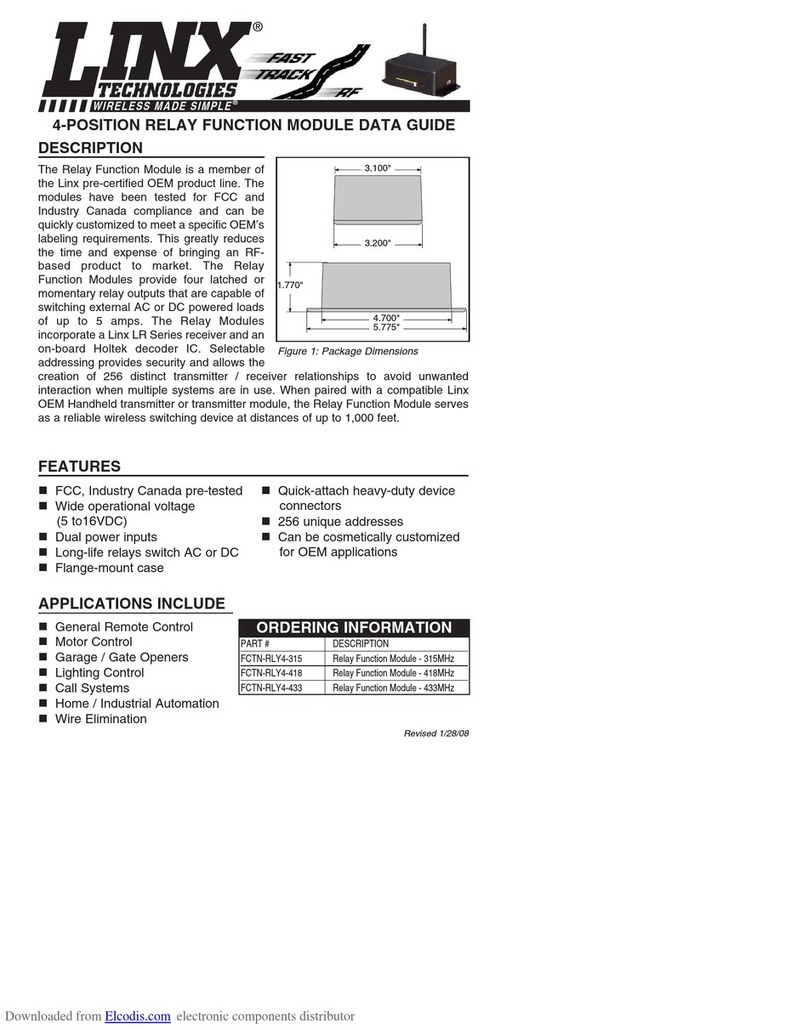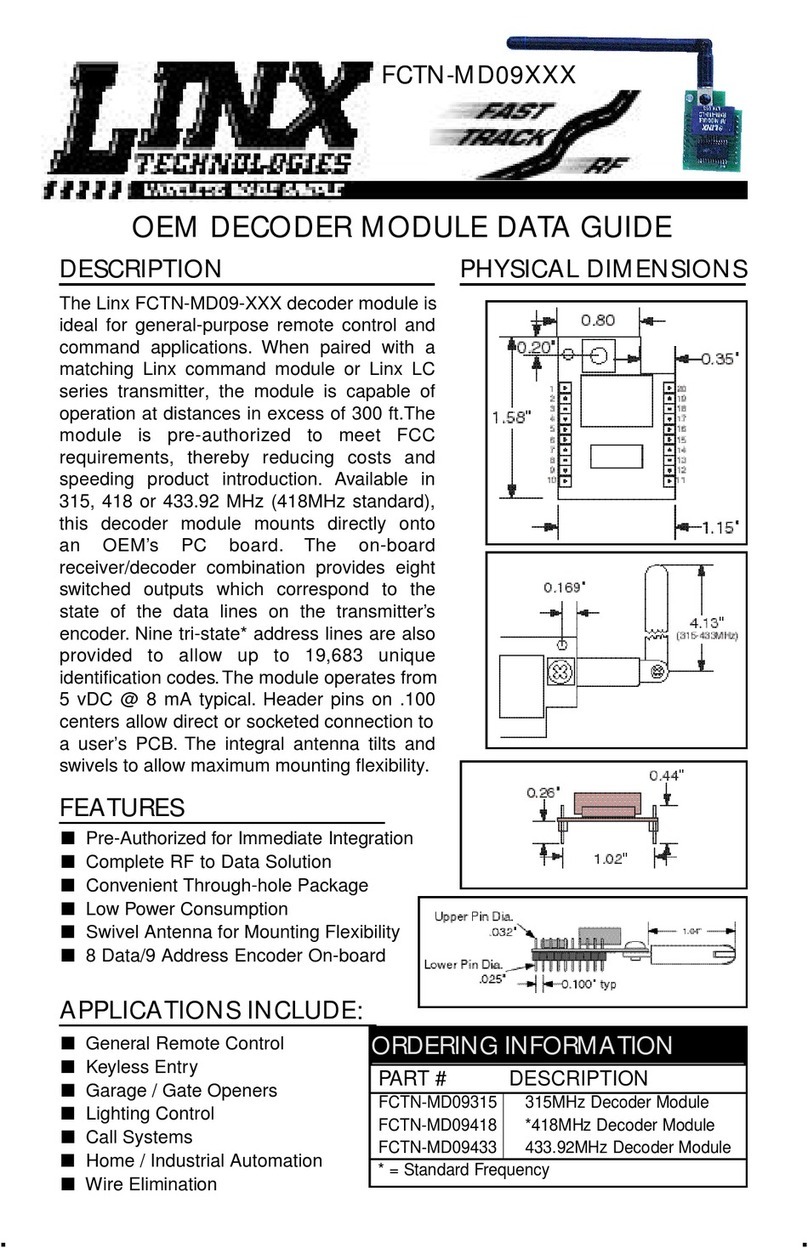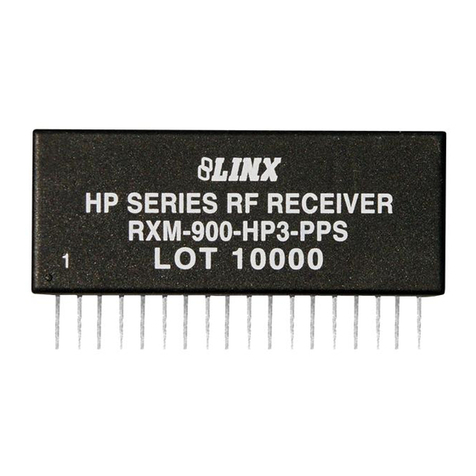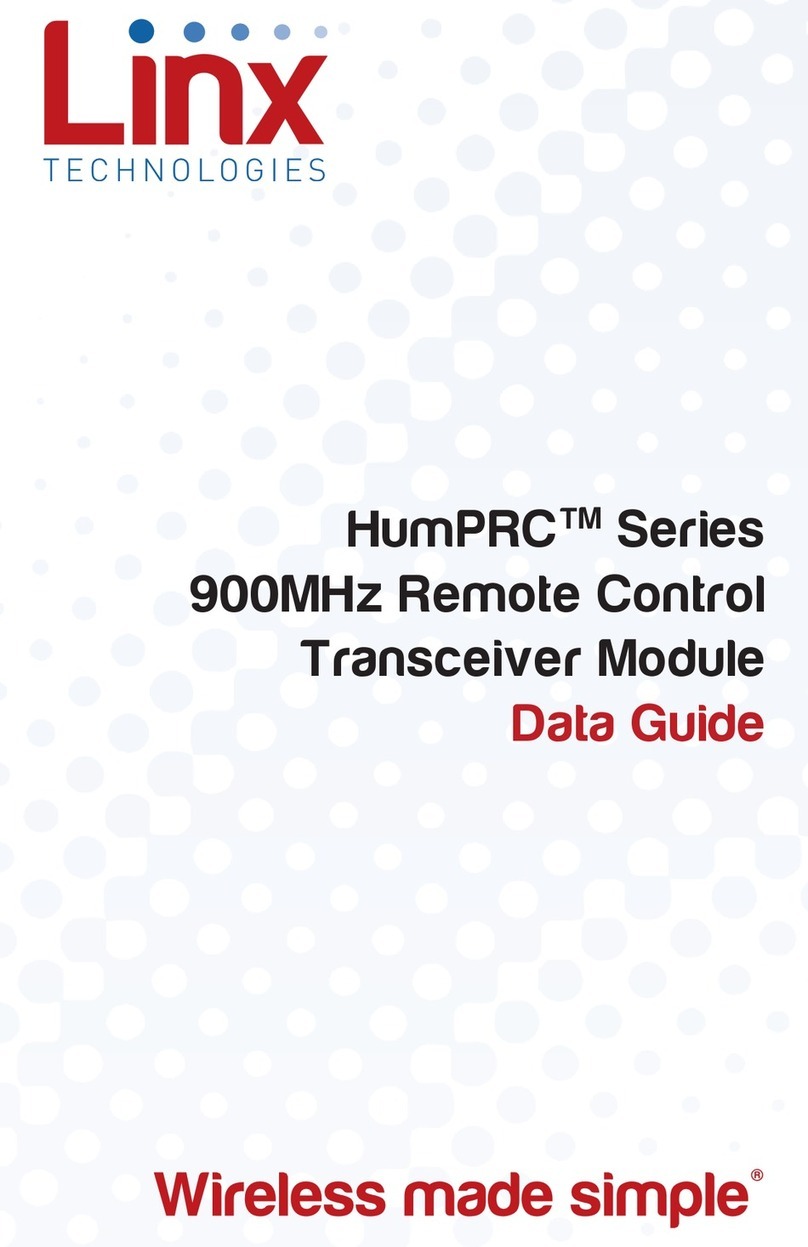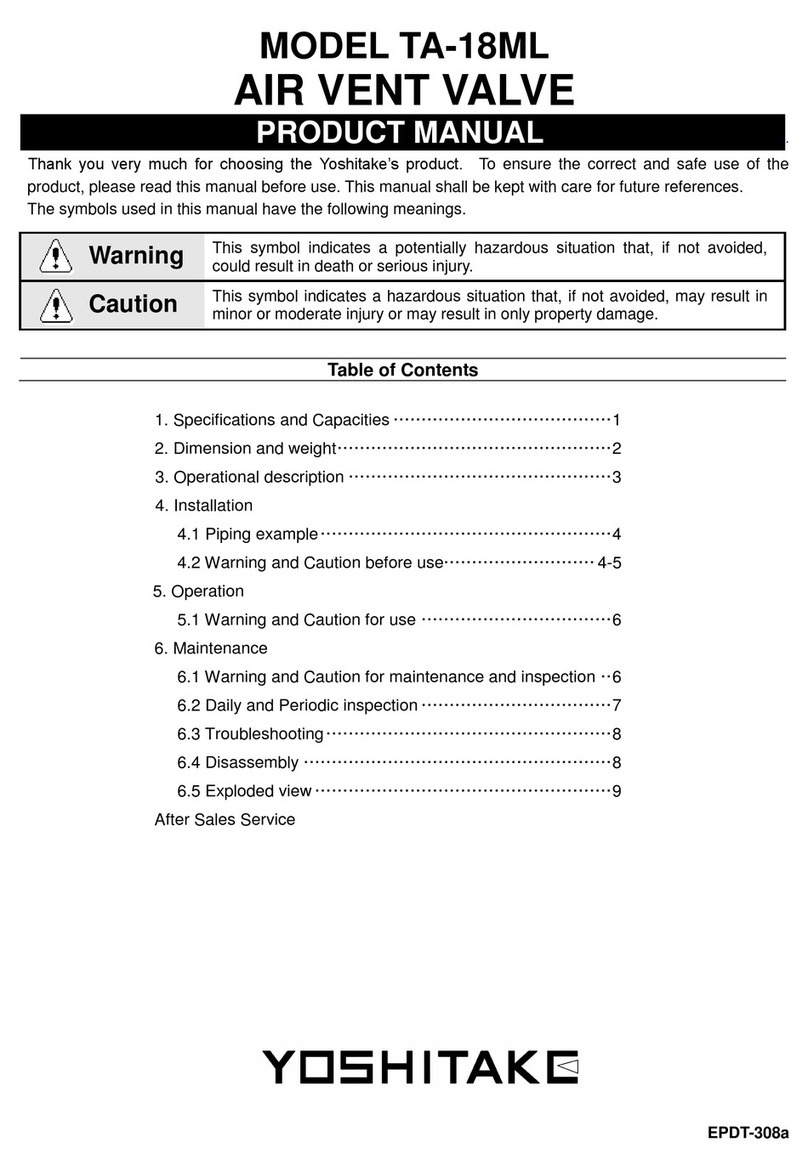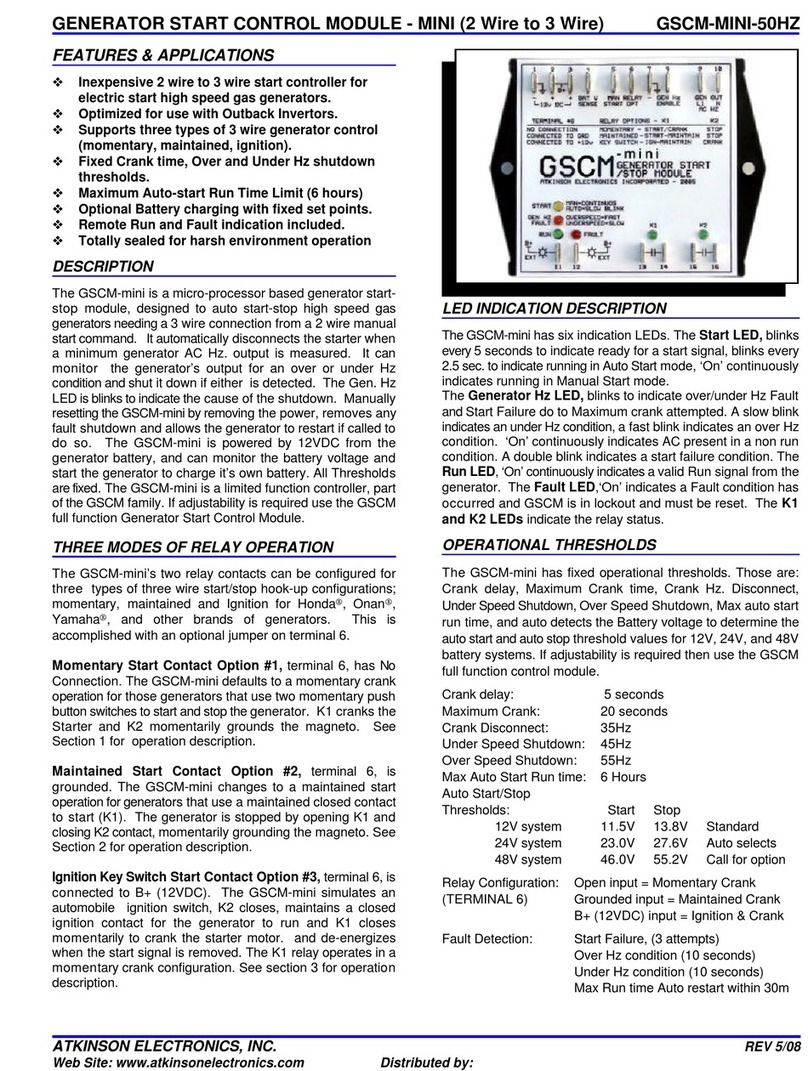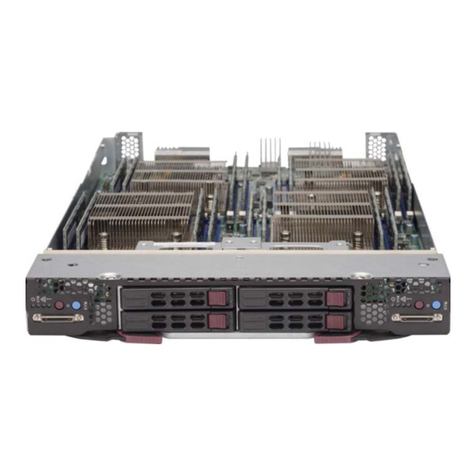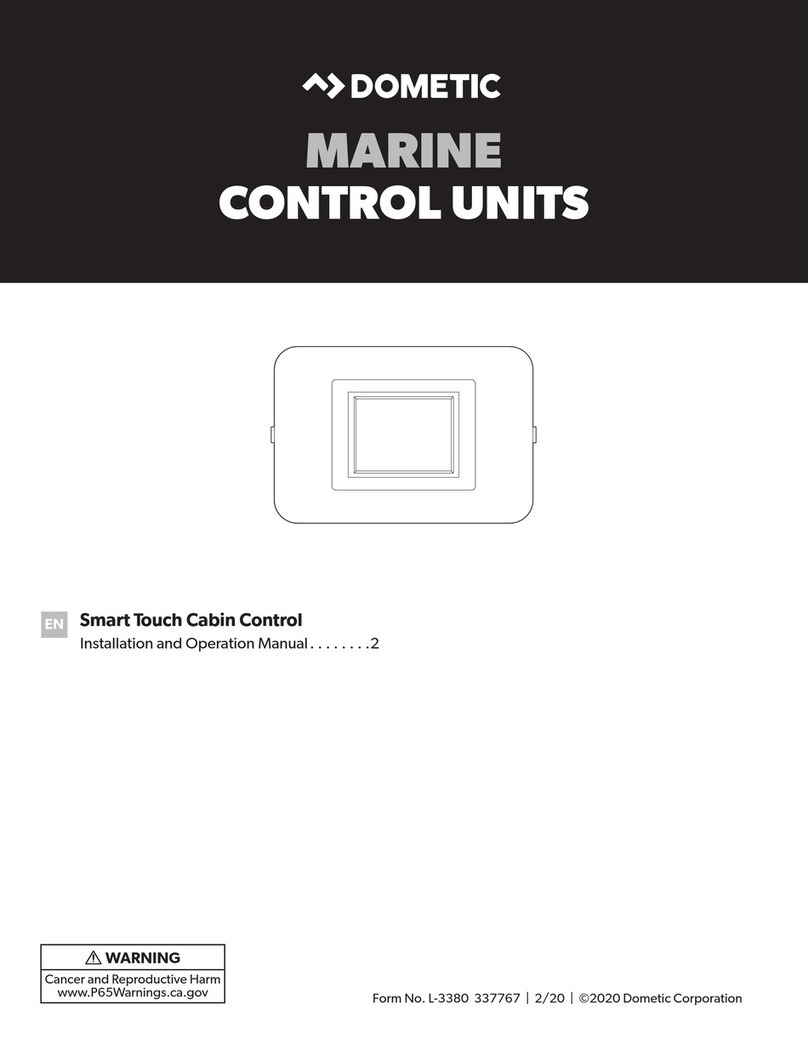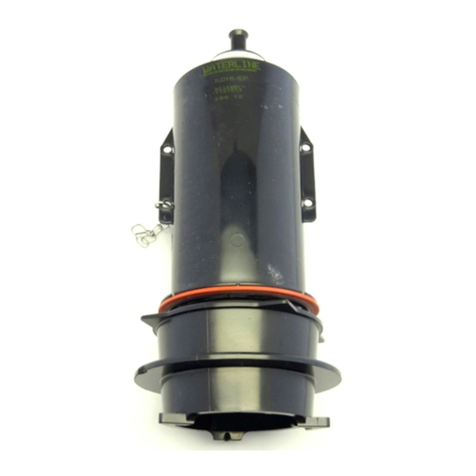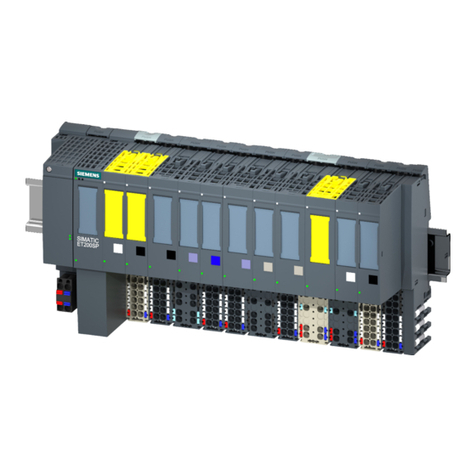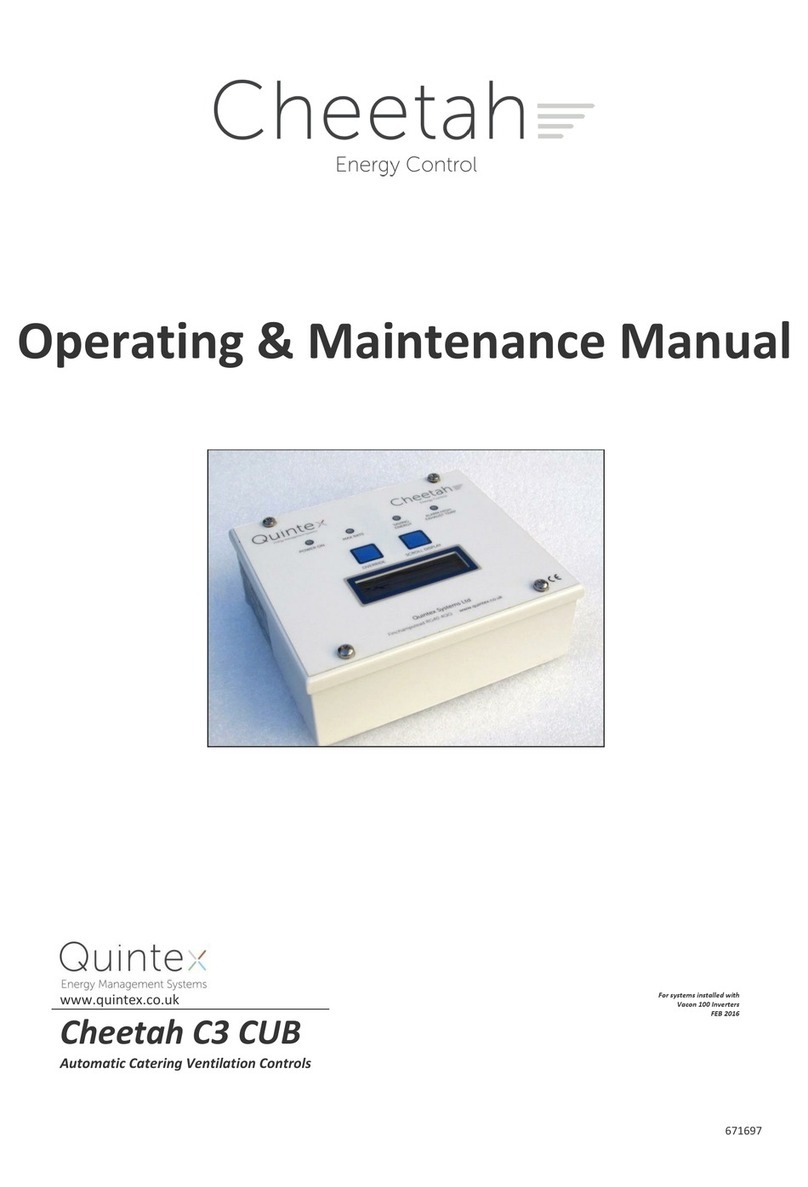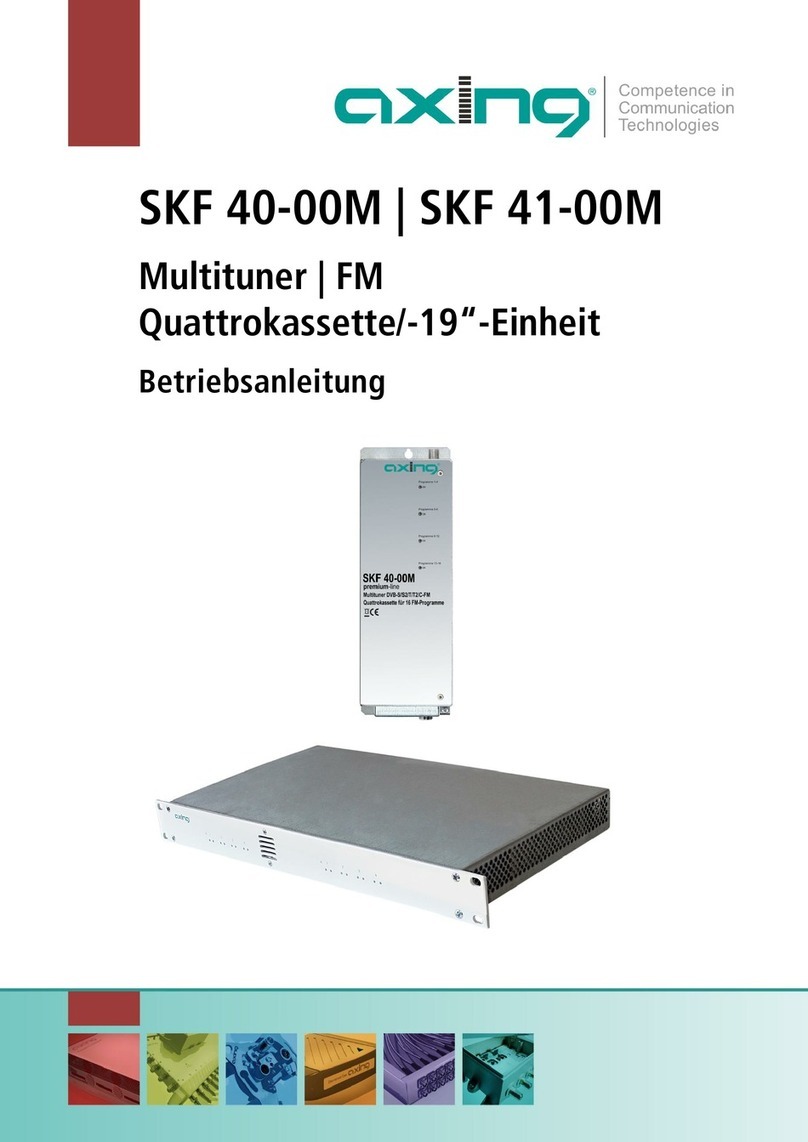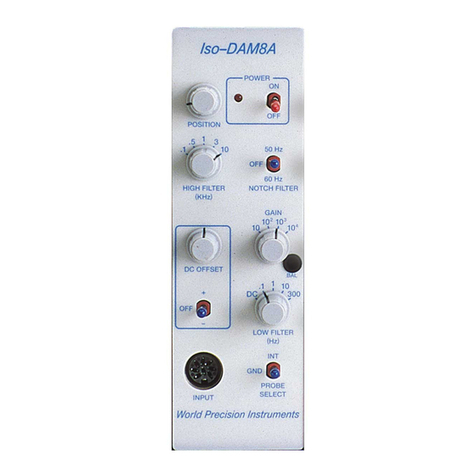Linx Technologies TRM-418-LT Instruction Manual

LT Series
Transceiver Module
Data Guide

Table of Contents
1 Description
1 Features
1 Applications
2 Ordering Information
2 Absolute Maximum Ratings
3 Electrical Specications
5 Typical Performance Graphs
9 PIN Assignments
9 Pin Descriptions
10 Module Description
10 Theory of Operation
12 Using LADJ
12 Using the RSSI Line
13 Using the PDN Line
13 ESD Concerns
14 Using the Data Line
15 Power Supply Requirements
16 Transferring Data
17 Typical Applications
18 Antenna Considerations
19 Helpful Application Notes from Linx
19 Protocol Guidelines
20 Interference Considerations
21 Pad Layout
21 Board Layout Guidelines
23 Microstrip Details
24 Production Guidelines
24 Hand Assembly
24 Automated Assembly
Warning: Some customers may want Linx radio frequency (“RF”)
products to control machinery or devices remotely, including machinery
or devices that can cause death, bodily injuries, and/or property
damage if improperly or inadvertently triggered, particularly in industrial
settings or other applications implicating life-safety concerns (“Life and
Property Safety Situations”).
NO OEM LINX REMOTE CONTROL OR FUNCTION MODULE
SHOULD EVER BE USED IN LIFE AND PROPERTY SAFETY
SITUATIONS. No OEM Linx Remote Control or Function Module
should be modified for Life and Property Safety Situations. Such
modification cannot provide sufficient safety and will void the product’s
regulatory certification and warranty.
Customers may use our (non-Function) Modules, Antenna and
Connectors as part of other systems in Life Safety Situations, but
only with necessary and industry appropriate redundancies and
in compliance with applicable safety standards, including without
limitation, ANSI and NFPA standards. It is solely the responsibility
of any Linx customer who uses one or more of these products to
incorporate appropriate redundancies and safety standards for the Life
and Property Safety Situation application.
Do not use this or any Linx product to trigger an action directly
from the data line or RSSI lines without a protocol or encoder/
decoder to validate the data. Without validation, any signal from
another unrelated transmitter in the environment received by the
module could inadvertently trigger the action.
All RF products are susceptible to RF interference that can prevent
communication. RF products without frequency agility or hopping
implemented are more subject to interference. This module does not
have a frequency hopping protocol built in.
Do not use any Linx product over the limits in this data guide.
Excessive voltage or extended operation at the maximum voltage could
cause product failure. Exceeding the reflow temperature profile could
cause product failure which is not immediately evident.
Do not make any physical or electrical modifications to any Linx
product. This will void the warranty and regulatory and UL certifications
and may cause product failure which is not immediately evident.
!

– –
1
Description
The LT Series transceiver is ideal for the bidirectional
wireless transfer of serial data, control or command
information in the favorable 260–470MHz band. The
transceiver is capable of generating +10dBm into a
50-ohm load and achieves an outstanding typical
sensitivity of –112dBm. Its advanced synthesized
architecture delivers outstanding stability and
frequency accuracy and minimizes the effects of
antenna pulling. When paired, the transceivers form a reliable wireless
link that is capable of transferring data at rates of up to 10,000bps over
distances of up to 3,000 feet (1000m). Applications operating over shorter
distances or at lower data rates will also benefit from increased link
reliability and superior noise immunity. Housed in a tiny reflow-compatible
SMD package, the transceiver requires no external RF components except
an antenna, which greatly simplifies integration and lowers assembly costs.
Features
• Long range
• Low cost
• PLL-synthesized architecture
• Direct serial interface
• Data rates up to 10,000bps
• No external RF components
required
• Low power consumption
• Compact surface-mount package
• Wide temperature range
• RSSI and power-down functions
• No production tuning
• Easy to use
Applications
• 2-way remote control
• Keyless entry
• Garage/gate openers
• Lighting control
• Medical monitoring/call systems
• Remote industrial monitoring
• Periodic data transfer
• Home/industrial automation
• Fire/security alarms/access
control
• Remote status/position sensing
• Long-range RFID
• Wire elimination
LT Series Transceiver Module
Data Guide
Revised 3/18/2015
0.125"
0.630"
0.619"
LOT TX4xxx
TRM-433-LT
26 General Antenna Rules
28 Common Antenna Styles
30 Regulatory Considerations
Figure 1: Package Dimensions

– – – –
2 3
LT Series Transceiver Specifications
Parameter Symbol Min. Typ. Max. Units Notes
Power Supply
Operating Voltage VCC 2.1 3.0 3.6 VDC
Supply Current lCC
TX Mode Logic High 12 14 mA 1
TX Mode Logic High 7.6 9.5 mA 2
TX Mode Logic Low 4.0 5.0 mA
Receive Mode 6.1 7.9 mA
Power Down Current lPDN 11.5 20.0 µA 9,10
DATA Line
Output Low Voltage VOL 0.15 VDC 3
Output High Voltage VOH VCC–0.26 VDC 4
Input Low Threshold VIL 0.1 VCC VDC 5
Input High Threshold VIH 0.9 VCC VDC
Power Down Input
Input Low Threshold VIL 0.1 VCC VDC 5
Input High Threshold VIH 0.9 VCC VDC
RF Section
Frequency Range FC
TRM-315-LT 315 MHz
TRM-418-LT 418 MHz
TRM-433-LT 433.92 MHz
Center Frequency
Accuracy –50 +50 kHz
Data Rate 65 10,000 bps
Receiver Section
LO Feedthrough –80 dBm 6,9
IF Frequency FIF 10.7 MHz 9
Noise Bandwidth N3DB 280 kHz 9
Receiver Sensitivity –108 –112 –118 dBm 7
RSSI / Analog
Dynamic Range 80 dB 9
Analog Bandwidth 20 5,000 Hz 9
Gain 15 mV/dB 9
Voltage with No Carrier 430 mV 9
Electrical SpecicationsOrdering Information
Ordering Information
Part Number Description
TRM-315-LT 315MHz Transceiver
TRM-418-LT 418MHz Transceiver
TRM-433-LT 433MHz Transceiver
EVAL-***-LT Basic Evaluation Kit
*** = 315, 418 (Standard), 433MHz
Transceivers are supplied in tubes of 18 pcs.
Absolute Maximum Ratings
Figure 2: Ordering Information
Absolute Maximum Ratings
Supply Voltage Vcc −0.3 to +4.0 VDC
Any Input or Output Pin −0.3 to VCC + 0.3 VDC
RF Input 0 dBm
Operating Temperature −40 to +85 ºC
Storage Temperature −65 to +150 ºC
Soldering Temperature +260ºC for 10 seconds
Exceeding any of the limits of this section may lead to permanent damage to the device.
Furthermore, extended operation at these maximum ratings may reduce the life of this
device.
Figure 3: Absolute Maximum Ratings
Warning: This product incorporates numerous static-sensitive
components. Always wear an ESD wrist strap and observe proper ESD
handling procedures when working with this device. Failure to observe
this precaution may result in module damage or failure.

– – – –
4 5
LT Series Transceiver Specifications Continued
Parameter Symbol Min. Typ. Max. Units Notes
Transmitter Section
Output Power PO+9.2 +11 dBm 1,6
With a 750Ωresistor
on LADJ PO–4 0.0 4 dBm 2,6
Output Power Control
Range –30 MAX dB 9
Harmonic Emissions PH–36 dBc 6
Antenna Port
RF Input Impedance RIN 50 Ω9
Timing
Receiver Turn-On Time
Via VCC 2.2 ms 8,9
Via PDN 0.25 ms 8,9
Max. Time Between
Transitions 15.0 ms 9
Transmtiter Turn-On Time
Via VCC 2.0 ms 9
Via PDN 500 µs 9
Modulation Delay 30.0 ns 9
Transmit to Receive
Switch Time 180 400 µs 9
Receive to Transmit
Switch Time 490 1000 µs 9
Dwell Time 290 µs 9,11
Environmental
Operating Temperature
Range –40 +85 ºC 9
1. With a 0Ωresistor on LADJ
2. With a 750Ωresistor on LADJ
3. ISINK = 500µA
4. ISOURCE = 500µA
5. ISINK = 20µA
6. Into a 50Ωload
7. With a 50% square wave at 1,000bps
8. Time to valid data output
9. Characterized, but not tested
10. Receive Mode on power down (see
Using the PDN Line section)
11. Minimum time before mode change
Figure 4: Electrical Specifications
Typical Performance Graphs
0
1
2
3
4
5
6
7
8
9
10
12.00 9.00 6.00 3.00 0.00 -3.00-6.00 -9.00-12.00 -15.00 -18.00 -21.00
Output Power (dBm)
LADJ Resistance (k
Ω
)
Figure 5: Output Power vs. LADJ Resistance
0
2
4
6
8
10
12
14
16
10 86420-2-4-6-8-10 -12-14
Output Power (dBm)
Supply Current (mA)
Figure 6: Output Power vs. Current Consumption
0
0.2
0.4
0.6
0.8
1
1.2
1.4
1.6
-115 -110 -105 -100 -95 -90 -85 -80 -75 -70 -65-60 -55-50 -45-40 -35-30
RF IN (dBm)
VRSSI (V)
Figure 7: RSSI Curve

– – – –
6 7
0.00
2.00
4.00
6.00
8.00
10.00
12.00
14.00
16.00
18.00
3.60 3.50 3.40 3.30 3.20 3.10 3.00 2.90 2.802.702.602.502.402.302.20
2.10
Supply Voltage (V) [LADJ = 0]
Supply Current (mA)
TX Icc
RX Icc
Figure 8: Current Consumption vs. Supply
1. 1.00V/div 2. 2.00V/div
200µS/div
1
2
Carrier
T/R SEL
Figure 9: RX to TX Change Time
1. 1.00V/div 2. 2.00V/div
2.00mS/div
1
2
DATA
VCC
Figure 10: TX to RX Change Time
1. 200mV/div 2. 2.00V/div
50.0nS/div
1
2
DATA
Carrier
1. 1.00V/div 2. 2.00V/div
500µS/div
1
2
PDN
DATA
NO RFIN
RFIN <-35dBm
1. 100mV/div
500µS/div
Figure 11: RX Turn-On Time from PDN
Figure 12: RSSI Response Time
Figure 13: TX Modulation Delay

– – – –
8 9
1. 200mV/div 2. 2.00V/div
200µS/div
1
2
PDN
Carrier
Figure 14: TX Turn-On Time from PDN
1. 200mV/div 2. 2.00V/div
1.00mS/div
1
2
Vcc
Carrier
Figure 15: TX Turn-On Time from VCC
1. 200mV/div 2. 2.00V/div
5.00µS/div
1
2
DATA
Carrier
Figure 16: TX Turn-Off Time
Pin Assignments
ANT
GND
NC GND
PDN
T/R SEL
DATA
RSSI
A REF
ANALOG
LADJ
VCC
1
2
3
4
5
6
7
8
9
10
11
12
Figure 17: LT Series Transceiver Pinout (Top View)
Pin Descriptions
Figure 18: LT Series Transceiver Pin Descriptions
Pin Descriptions
Pin Number Name I/O Description
1ANT — 50ΩRF Port
2 GND — Analog Ground
3 NC — No Connection
4 RSSI O
Received Signal Strength Indicator. This line
will supply an analog voltage proportional to
the received signal strength.
5 A REF O Analog RMS (Average) Voltage Reference
6 ANALOG O Recovered Analog Output
7DATA I/O
Digital Data Line. This line outputs the
received data when in Receive Mode and is
the data input when in Transmit Mode.
8 T/R_SEL I
Transmit/Receive Select. Pull this line low to
place the transceiver into receive mode. Pull
high to place into transmit mode.
9 PDN I
Power Down. Pull this line low or leave
floating to place the receiver into a
low-current state. The module is not be able
to send or receive a signal in this state. Pull
high to activate the transceiver.
10 GND — Analog Ground
11 VCC — Supply Voltage
12 LADJ/VCC I
Level Adjust. This line is used to adjust
the output power level of the transmitter.
Connecting to VCC gives the highest output,
while placing a resistor to VCC lowers the
output level (see Figure 5).

– – – –
10 11
Module Description
The LT Series transceiver is a low-cost, high-performance synthesized
AM OOK transceiver capable of transmitting and receiving serial data at
up to 10,000bps over line-of-site distances of up to 3,000 feet (1000m).
Its exceptional receiver sensitivity and highly stable transmitter output
result in outstanding range performance. The transceiver is completely
self-contained and does not require any additional RF components except
an antenna. This greatly simplifies the design process, reduces time to
market, and reduces production assembly and testing costs. The LT
is housed in a compact surface-mount package that integrates easily
into existing designs and is equally friendly to prototyping and volume
production. The module’s low power consumption makes it ideal for
battery-powered products.
Theory of Operation
The LT Series transceiver sends and
recovers data by AM or Carrier-Present
Carrier-Absent (CPCA) modulation, also
referred to as On-Off Keying (OOK). This
type of modulation represents a logic low
‘0’ by the absence of a carrier and a logic high ‘1’ by the presence of a
carrier (Figure 20). This method affords numerous benefits. The two most
important are: 1) cost-effectiveness due to design simplicity and 2) higher
legally-allowable output power and thus greater range in countries (such as
the US) that average output power measurements over time.
The LT’s receiver chain utilizes an advanced synthesized superheterodyne
architecture and achieves exceptional sensitivity. Transmitted signals
enter the module through a 50-ohm RF port intended for single-ended
connection to an external antenna. RF signals entering the antenna are
filtered and then amplified by an NMOS cascode Low Noise Amplifier
(LNA). The signal is then down-converted to a 10.7MHz Intermediate
Frequency (IF) by mixing it with a low-side Local Oscillator (LO). The LO
frequency is generated by a Voltage Controlled Oscillator (VCO) which is
locked by a Phase-Locked Loop (PLL) frequency synthesizer referenced
to a precision crystal. The mixer stage is a pair of double-balanced mixers
and a unique image rejection circuit, which greatly reduces susceptibility to
interference. The IF frequency is further amplified, filtered, and demodulated
to recover the original signal. The signal is squared by a data slicer and
output on the DATA line.
The LT’s transmitter chain is designed to generate up to 10mW of output
power into a 50-ohm single-ended antenna while suppressing harmonics
and spurious emissions. The transmitter is comprised of a VCO locked
by the PLL. The output of the VCO is amplified and buffered by a power
amplifier. The amplifier is switched by the incoming data to produce a
modulated carrier. The internal digital logic controls a switch that connects
the LNA input to ground when in transmit mode, preventing the transmitter
from de-sensitizing the receiver. The carrier is filtered to attenuate
harmonics, and then output on the 50-ohm RF port.
The transceiver’s topology makes the module highly immune to frequency
pulling, mismatch, temperature, and other negative effects common
to some low-cost architectures. The LT Series design and component
quality enable it to outperform many far more expensive transceiver
products, making it well-suited for a wide range of consumer and industrial
applications.
Data Slicer
LNA
RX VCO PLL
XTAL
0°
90°
Limiter
RX Data
Analog
∑
10.7MHz
IF Filter
Band Select
Filter
50ΩRF IN
(Antenna)
+
-
Digital
Logic
TX VCO
RSSI
A REF
PA
PDN
T/R SEL
DATA
GND
Figure 19: LT Series Transceiver Block Diagram
Carrier
ON
OFF
Data
Figure 20: CPCA (AM) Modulation

– – – –
12 13
Using LADJ
The Level Adjust (LADJ) line allows the transceiver’s output power to be
easily adjusted for range control, lower power consumption, or to meet
legal requirements. This is done by placing a resistor between VCC and
LADJ. The value of the resistor determines the output power level. When
LADJ is connected to VCC, the output power and current consumption
are the highest. Figure 5 shows a graph of the output power vs. LADJ
resistance.
This line is very useful during FCC testing to compensate for antenna
gain or other product-specific issues that may cause the output power
to exceed legal limits. A variable resistor can be temporarily used so that
the test lab can precisely adjust the output power to the maximum level
allowed by law. The variable resistor’s value can be noted and a fixed
resistor substituted for final testing. Even in designs where attenuation is
not anticipated, it is a good idea to place a resistor pad connected to LADJ
and VCC so that it can be used if needed. For more sophisticated designs,
LADJ can also be controlled by a digital potentiometer to allow precise and
digitally-variable output power control.
Using the RSSI Line
The transceiver’s Received Signal Strength Indicator (RSSI) line serves a
variety of functions. This line has a dynamic range of 80dB (typical) and
outputs a voltage proportional to the incoming signal strength. The RSSI
levels and dynamic range vary slightly from part to part. It is important
to remember that the RSSI output indicates the strength of any in-band
RF energy and not necessarily just that from the intended transmitter;
therefore, it should be used only to qualify the level and presence
of a signal. Using RSSI to determine distance or data validity is not
recommended.
The RSSI output can be utilized during testing, or even as a product
feature, to assess interference and channel quality by looking at the RSSI
level with all intended transmitters shut off. RSSI can also be used in
direction-finding applications, although there are many potential perils to
consider in such systems. Finally, it can be used to save system power by
“waking up” external circuitry when a transmission is received or crosses a
certain threshold. The RSSI output feature adds tremendous versatility for
the creative designer.
Using the PDN Line
The Power Down (PDN) line can be used to power down the transceiver
without the need for an external switch. This line has an internal pull-down,
so when it is held low or simply left floating, the module is inactive.
When the PDN line is pulled to ground, the transceiver enters into a
low-current (~20µA) power-down mode. During this time the transceiver
is off and cannot perform any function. It may be useful to note that the
startup time from power-down is slightly less than when applying VCC.
The PDN line allows easy control of the receiver state from external
components, such as a microcontroller. By periodically activating the
transceiver, sending data, then powering down, the transceiver’s average
current consumption can be greatly reduced, saving power in battery-
operated applications.
ESD Concerns
The module has basic ESD protection built in, but in cases where the
antenna connection is exposed to the user it is a good idea to add
additional protection. A Transient Voltage Suppressor (TVS) diode, varistor
or similar component can be added to the antenna line. These should have
low capacitance and be designed for use on antennas. Protection on the
supply line is a good idea in designs that have a user-accessible power
port.
Note: If the T/R_SEL line is toggled when the transceiver is powered
down, internal logic wakes up and increases the current consumption to
approximately 350µA. When high, the T/R_SEL line sinks approximately
15µA, so the lowest current consumption is obtained by placing the LT
into receive mode before powering down.

– – – –
14 15
It is important to recognize that in many actual use environments, ambient
noise and interference may enter the receiver at levels well above the
squelch threshold. For this reason, it is always recommended that the
product’s protocol be structured to allow for the possibility of hashing, even
when an external squelch circuit is employed.
Power Supply Requirements
The module does not have an internal
voltage regulator; therefore it requires a
clean, well-regulated power source. While
it is preferable to power the unit from a
battery, it can also be operated from a
power supply as long as noise is less than
20mV. Power supply noise can affect the
transmitter modulation; therefore, providing
a clean power supply for the module should
be a high priority during design.
A 10Ωresistor in series with the supply followed by a 10µF tantalum
capacitor from VCC to ground will help in cases where the quality of the
supply is poor. Note that the values may need to be adjusted depending on
the noise present on the supply line.
Using the Data Line
The CMOS-compatible DATA line is used for both the transmitter data and
the recovered receiver data. Its function is controlled by the state of the
T/R_ SEL line, so it is an input when in transmit mode and an output when
in receive mode. The output is normally connected to a transcoder IC or a
microprocessor for data encoding and decoding.
It is important to note that the transceiver does not provide hysteresis or
squelching of the DATA line when in receive mode. This means that, in the
absence of a valid transmission or transitional data, the DATA line switches
randomly. This noise can be handled in software by implementing a noise-
tolerant protocol as described in Linx Application Note AN-00160. If a
software solution is not appropriate, then the transceiver can be squelched.
Squelching disables the DATA output when the RSSI voltage falls below a
reference level. This prevents low amplitude noise from causing the DATA
line to switch, reducing hash during times that the transmitter is off or
during transmitter steady-state times which exceed 15ms.
The voltage on the A REF line is the analog reference voltage that is used
by the transceiver’s data circuit. The received signal must be higher than
this voltage for the DATA line to activate and must then fall lower than this
output for the DATA line to deactivate. This voltage dynamically follows the
midpoint of the received signal’s voltage. There is always about 30mVp-p
noise riding on the signal’s voltage. During times with no carrier or during
transmitter steady-state times exceeding 15mS, the reference voltage
reaches a point where the noise causes the output to switch randomly.
To squelch the DATA line, an offset can be added to the A REF line by
connecting a resistor to VCC. This offset keeps the reference voltage above
the noise, and quiets the DATA line. Typical resistor values are between
1M-ohm and 10M-ohm.
Squelching the output reduces the sensitivity of the receiver and therefore
the range of the system. For this reason, the squelch threshold is normally
set as low as possible, but the designer can make the compromise
between noise level on the DATA line and range of the system. Figure
21 shows a graph of the sensitivity vs. the squelch resistor. Note that
squelching causes some bit stretching and contracting, which could affect
PWM-based protocols.
-118
-116
-114
-112
-110
-108
-106
-104
-102
Open 10 9.18.2 7.56.8 6.25.6 5.14.7 4.33.9 3.63.3 32.7 2.22 1.61.3 1
Higher Sensitivity, More Hash
Lower Sensitivity, Less Hash
Sensitivity (dBm)
Resistor Value (MΩ)
Figure 21: Sensitivity Degradation vs. Squelch Resistor
+
10Ω
10µF
Vcc IN
Vcc TO
MODULE
Figure 22: Supply Filter

– – – –
16 17
Transferring Data
Once a reliable RF link has been established, the challenge becomes how
to effectively transfer data across it. While a properly designed RF link
provides reliable data transfer under most conditions, there are still distinct
differences from a wired link that must be addressed. The LT Series is
intended to be as transparent as possible and does not incorporate internal
encoding or decoding, so a user has tremendous flexibility in how data is
handled.
If the product transfers simple control or status signals such as button
presses or switch closures and it does not have a microprocessor on board
(or it is desired to avoid protocol development), consider using a remote
control encoder and decoder or a transcoder IC. These chips are available
from a wide range of manufacturers including Linx. They take care of all
encoding and decoding functions, and generally provide a number of data
pins to which switches can be directly connected. In addition, address bits
are usually provided for security and to allow the addressing of multiple
units independently. These ICs are an excellent way to bring basic remote
control / status products to market quickly and inexpensively. Additionally,
it is a simple task to interface with inexpensive microprocessors, IR, remote
control or modem ICs.
It is always important to separate the types of transmissions that are
technically possible from those that are legally allowable in the country
of intended operation. Linx Application Notes AN-00125, AN-00128
and AN-00140 should be reviewed, along with Part 15, Section 231 of
the Code of Federal Regulations for further details regarding acceptable
transmission content in the US All of these documents can be downloaded
from the Linx website at www.linxtechnologies.com.
Another area of consideration is that the data structure can affect the
output power level. The FCC allows output power in the 260 to 470MHz
band to be averaged over a 100ms time frame. Because OOK modulation
activates the carrier for a ‘1’ and deactivates the carrier for a ‘0’, a data
stream that sends more ‘0’s has a lower average output power over
100ms. This allows the instantaneous output power to be increased, thus
extending range.
Typical Applications
The LT Series transceiver does not perform any encoding or decoding of
the data, so the designer has a great deal of flexibility in the design of a
protocol for the system. The data source and destination can be any device
that uses asynchronous serial data such as a PC or a microcontroller. If the
application is for remote control or command, then the easiest solution is
to use a remote control encoder and decoder. These ICs provide a number
of data lines that can be connected to switches or buttons or even a
microcontroller. When a line is taken high on the encoder, a corresponding
line goes high on the decoder as long as the address matches. The Linx
MT Series transcoder is an encoder and decoder in a single chip which
allows bidirectional control and confirmation using a transceiver. Figure 23
shows a circuit using the Linx LICAL-TRC-MT transcoder.
The MT Series has eight data lines, which can be set as inputs and
connected to buttons that pull the line high when pressed, or set as
outputs to activate external circuitry. When not used, the lines are pulled
low by 100k-ohm resistors. The transcoder begins a transmission when
any of the input data lines are taken high. When a valid transmission is
received, the transcoder activates the appropriate output data lines and
then sends a confirmation back to the originating transcoder. When the
confirmation is received, the originating transcoder activates its CONFIRM
line. In this example, this turns on an LED for visual indication. The
transcoder automatically controls the power to the transceiver via the PDN
line and the transmit / receive state via the T/R_SEL line.
The MT Series transcoder data guide explains this circuit and the features
of the transcoder in detail, so please refer to that for more information.
A 750-ohm resistor is used on the LADJ line of the transceiver to reduce
the output power of the transmitter to meet North American certification
requirements. This value may need to be adjusted depending on antenna
efficiency and the power allowed in the country of operation.
GND
VCC
GND
GND
750 ohm
100K
VCC
GND
GND
GND
100k GND
VCC VCC
D6
D7
CRT/LRN
ENC SEL
SER IO
CONFIRM
T/R PDN
T/R SEL
T/R DATA D0
D1
D2
MODE IND
BAUD SEL
LATCH
D3
D4
D5
GND
LICAL-TRC-MT
GND
200 ohm
GND
200 ohm
RF
1
GND
2
NC
3
RSSI
4
A REF
5
ANALOG
6DATA 7
T/R SEL 8
PDN 9
GND 10
VCC 11
LADJ 12
TRM-XXX-LT
GND
VCC
VCC
GND
100k
VCC
GND
100k
VCC
BUZZER
GND
GND
GND
GND
200 ohm
GND
Figure 23: LT Series Transceiver and MT Series Transcoder

– – – –
18 19
Antenna Considerations
The choice of antennas is a
critical and often overlooked
design consideration. The range,
performance and legality of an RF
link are critically dependent upon the
antenna. While adequate antenna
performance can often be obtained
by trial and error methods, antenna
design and matching is a complex
task. Professionally designed antennas such as those from Linx (Figure
24) help ensure maximum performance and FCC and other regulatory
compliance.
Linx transmitter modules typically have an output power that is higher
than the legal limits. This allows the designer to use an inefficient antenna
such as a loop trace or helical to meet size, cost or cosmetic requirements
and still achieve full legal output power for maximum range. If an efficient
antenna is used, then some attenuation of the output power will likely be
needed. This can easily be accomplished by using the LADJ line.
It is usually best to utilize a basic quarter-wave whip until your prototype
product is operating satisfactorily. Other antennas can then be evaluated
based on the cost, size and cosmetic requirements of the product.
Additional details are in Application Note AN-00500.
Figure 24: Linx Antennas
Helpful Application Notes from Linx
It is not the intention of this manual to address in depth many of the issues
that should be considered to ensure that the modules function correctly
and deliver the maximum possible performance. We recommend reading
the application notes listed in Figure 25 which address in depth key areas
of RF design and application of Linx products. These applications notes are
available online at www.linxtechnologies.com or by contacting Linx.
Protocol Guidelines
While many RF solutions impose data formatting and balancing
requirements, Linx RF modules do not encode or packetize the signal
content in any manner. The received signal will be affected by such factors
as noise, edge jitter and interference, but it is not purposefully manipulated
or altered by the modules. This gives the designer tremendous flexibility for
protocol design and interface.
Despite this transparency and ease of use, it must be recognized that there
are distinct differences between a wired and a wireless environment. Issues
such as interference and contention must be understood and allowed for in
the design process. To learn more about protocol considerations, read Linx
Application Note AN-00160.
Interference or changing signal conditions can corrupt the data packet,
so it is generally wise to structure the data being sent into small packets.
This allows errors to be managed without affecting large amounts of data.
A simple checksum or CRC could be used for basic error detection. Once
an error is detected, the protocol designer may wish to simply discard the
corrupt data or implement a more sophisticated scheme to correct it.
Helpful Application Note Titles
Note Number Note Title
AN-00100 RF 101: Information for the RF Challenged
AN-00125 Considerations for Operation Within the 260–470MHz Band
AN-00130 Modulation Techniques for Low-Cost RF Data Links
AN-00128 Data and Bidirectional Transmissions Under Part 15.231
AN-00140 The FCC Road: Part 15 from Concept to Approval
AN-00160 Considerations for Sending Data over a Wireless Link
AN-00500 Antennas: Design, Application, Performance
AN-00501 Understanding Antenna Specifications and Operation
Figure 25: Helpful Application Note Titles

– – – –
20 21
Interference Considerations
The RF spectrum is crowded and the potential for conflict with unwanted
sources of RF is very real. While all RF products are at risk from
interference, its effects can be minimized by better understanding its
characteristics.
Interference may come from internal or external sources. The first step
is to eliminate interference from noise sources on the board. This means
paying careful attention to layout, grounding, filtering and bypassing in
order to eliminate all radiated and conducted interference paths. For
many products, this is straightforward; however, products containing
components such as switching power supplies, motors, crystals and other
potential sources of noise must be approached with care. Comparing your
own design with a Linx evaluation board can help to determine if and at
what level design-specific interference is present.
External interference can manifest itself in a variety of ways. Low-level
interference produces noise and hashing on the output and reduces the
link’s overall range.
High-level interference is caused by nearby products sharing the same
frequency or from near-band high-power devices. It can even come from
your own products if more than one transmitter is active in the same area.
It is important to remember that only one transmitter at a time can occupy
a frequency, regardless of the coding of the transmitted signal. This type of
interference is less common than those mentioned previously, but in severe
cases it can prevent all useful function of the affected device.
Although technically not interference, multipath is also a factor to be
understood. Multipath is a term used to refer to the signal cancellation
effects that occur when RF waves arrive at the receiver in different phase
relationships. This effect is a particularly significant factor in interior
environments where objects provide many different signal reflection paths.
Multipath cancellation results in lowered signal levels at the receiver and
shorter useful distances for the link.
Pad Layout
The pad layout diagram in Figure 26 is designed to facilitate both hand and
automated assembly.
Board Layout Guidelines
The module’s design makes integration straightforward; however, it
is still critical to exercise care in PCB layout. Failure to observe good
layout techniques can result in a significant degradation of the module’s
performance. A primary layout goal is to maintain a characteristic
50-ohm impedance throughout the path from the antenna to the module.
Grounding, filtering, decoupling, routing and PCB stack-up are also
important considerations for any RF design. The following section provides
some basic design guidelines.
During prototyping, the module should be soldered to a properly laid-out
circuit board. The use of prototyping or “perf” boards results in poor
performance and is strongly discouraged. Likewise, the use of sockets
can have a negative impact on the performance of the module and is
discouraged.
The module should, as much as reasonably possible, be isolated from
other components on your PCB, especially high-frequency circuitry such as
crystal oscillators, switching power supplies, and high-speed bus lines.
When possible, separate RF and digital circuits into different PCB regions.
Figure 26: Recommended PCB Layout
0.100"
0.070"
0.065"
0.610"

– – – –
22 23
Microstrip Details
A transmission line is a medium whereby RF energy is transferred from
one place to another with minimal loss. This is a critical factor, especially
in high-frequency products like Linx RF modules, because the trace
leading to the module’s antenna can effectively contribute to the length
of the antenna, changing its resonant bandwidth. In order to minimize
loss and detuning, some form of transmission line between the antenna
and the module should be used unless the antenna can be placed very
close (<1/8in) to the module. One common form of transmission line is a
coax cable and another is the microstrip. This term refers to a PCB trace
running over a ground plane that is designed to serve as a transmission line
between the module and the antenna. The width is based on the desired
characteristic impedance of the line, the thickness of the PCB and the
dielectric constant of the board material. For standard 0.062in thick FR-4
board material, the trace width would be 111 mils. The correct trace width
can be calculated for other widths and materials using the information in
Figure 27 and examples are provided in Figure 28. Software for calculating
microstrip lines is also available on the Linx website.
Trace
Board
Ground plane
Figure 27: Microstrip Formulas
Example Microstrip Calculations
Dielectric Constant Width / Height
Ratio (W / d)
Effective Dielectric
Constant
Characteristic
Impedance (Ω)
4.80 1.8 3.59 50.0
4.00 2.0 3.07 51.0
2.55 3.0 2.12 48.8
Figure 28: Example Microstrip Calculations
Make sure internal wiring is routed away from the module and antenna and
is secured to prevent displacement.
Do not route PCB traces directly under the module. There should not be
any copper or traces under the module on the same layer as the module,
just bare PCB. The underside of the module has traces and vias that could
short or couple to traces on the product’s circuit board.
The Pad Layout section shows a typical PCB footprint for the module. A
ground plane (as large and uninterrupted as possible) should be placed on
a lower layer of your PC board opposite the module. This plane is essential
for creating a low impedance return for ground and consistent stripline
performance.
Use care in routing the RF trace between the module and the antenna
or connector. Keep the trace as short as possible. Do not pass it under
the module or any other component. Do not route the antenna trace on
multiple PCB layers as vias add inductance. Vias are acceptable for tying
together ground layers and component grounds and should be used in
multiples.
Each of the module’s ground pins should have short traces tying
immediately to the ground plane through a via.
Bypass caps should be low ESR ceramic types and located directly
adjacent to the pin they are serving.
A 50-ohm coax should be used for connection to an external antenna.
A 50-ohm transmission line, such as a microstrip, stripline or coplanar
waveguide should be used for routing RF on the PCB. The Microstrip
Details section provides additional information.
In some instances, a designer may wish to encapsulate or “pot” the
product. There are a wide variety of potting compounds with varying
dielectric properties. Since such compounds can considerably impact
RF performance and the ability to rework or service the product, it is
the responsibility of the designer to evaluate and qualify the impact and
suitability of such materials.

– – – –
24 25
Production Guidelines
The module is housed in a hybrid SMD package that supports hand and
automated assembly techniques. Since the modules contain discrete
components internally, the assembly procedures are critical to ensuring
the reliable function of the modules. The following procedures should be
reviewed with and practiced by all assembly personnel.
Hand Assembly
Pads located on the bottom
of the module are the primary
mounting surface (Figure 29).
Since these pads are inaccessible
during mounting, castellations
that run up the side of the module
have been provided to facilitate
solder wicking to the module’s
underside. This allows for very
quick hand soldering for prototyping and small volume production. If the
recommended pad guidelines have been followed, the pads will protrude
slightly past the edge of the module. Use a fine soldering tip to heat the
board pad and the castellation, then introduce solder to the pad at the
module’s edge. The solder will wick underneath the module, providing
reliable attachment. Tack one module corner first and then work around the
device, taking care not to exceed the times in Figure 30.
Automated Assembly
For high-volume assembly, the modules are generally auto-placed.
The modules have been designed to maintain compatibility with reflow
processing techniques; however, due to their hybrid nature, certain aspects
of the assembly process are far more critical than for other component
types. Following are brief discussions of the three primary areas where
caution must be observed.
Castellations
PCB Pads
Soldering Iron
Tip
Solder
Figure 29: Soldering Technique
Warning: Pay attention to the absolute maximum solder times.
Figure 30: Absolute Maximum Solder Times
Absolute Maximum Solder Times
Hand Solder Temperature: +427ºC for 10 seconds for lead-free alloys
Reflow Oven: +255ºC max (see Figure 31)
Reflow Temperature Profile
The single most critical stage in the automated assembly process is the
reflow stage. The reflow profile in Figure 31 should not be exceeded
because excessive temperatures or transport times during reflow will
irreparably damage the modules. Assembly personnel need to pay careful
attention to the oven’s profile to ensure that it meets the requirements
necessary to successfully reflow all components while still remaining
within the limits mandated by the modules. The figure below shows the
recommended reflow oven profile for the modules.
Shock During Reflow Transport
Since some internal module components may reflow along with the
components placed on the board being assembled, it is imperative that
the modules not be subjected to shock or vibration during the time solder
is liquid. Should a shock be applied, some internal components could be
lifted from their pads, causing the module to not function properly.
Washability
The modules are wash-resistant, but are not hermetically sealed. Linx
recommends wash-free manufacturing; however, the modules can be
subjected to a wash cycle provided that a drying time is allowed prior
to applying electrical power to the modules. The drying time should be
sufficient to allow any moisture that may have migrated into the module
to evaporate, thus eliminating the potential for shorting damage during
power-up or testing. If the wash contains contaminants, the performance
may be adversely affected, even after drying.
125°C
185°C
217°C
255°C
235°C
60 12030 150180 210240 270300 330360090
50
100
150
200
250
300
Recommended RoHS Profile
Max RoHS Profile
Recommended Non-RoHS Profile
180°C
Temperature (oC)
Time (Seconds)
Figure 31: Maximum Reflow Temperature Profile

– – – –
26 27
General Antenna Rules
The following general rules should help in maximizing antenna performance.
1. Proximity to objects such as a user’s hand, body or metal objects will
cause an antenna to detune. For this reason, the antenna shaft and tip
should be positioned as far away from such objects as possible.
2. Optimum performance is obtained from a ¼- or ½-wave straight whip
mounted at a right angle to the ground plane (Figure 32). In many
cases, this isn’t desirable for practical or ergonomic reasons, thus,
an alternative antenna style such as a helical, loop or patch may be
utilized and the corresponding sacrifice in performance accepted.
3. If an internal antenna is to be used, keep it away from other metal
components, particularly large items like transformers, batteries,
PCB tracks and ground planes. In many cases, the space around the
antenna is as important as the antenna itself. Objects in close proximity
to the antenna can cause direct detuning, while those farther away will
alter the antenna’s symmetry.
4. In many antenna designs, particularly ¼-wave whips, the ground plane
acts as a counterpoise, forming, in essence,
a ½-wave dipole (Figure 33). For this reason,
adequate ground plane area is essential.
The ground plane can be a metal case or
ground-fill areas on a circuit board. Ideally, it
should have a surface area less than or equal
to the overall length of the ¼-wave radiating
element. This is often not practical due to
size and configuration constraints. In these
instances, a designer must make the best use
of the area available to create as much ground
OPTIMUM
USABLE NOT RECOMMENDED
NUT GROUND PLANE
(MAY BE NEEDED)
CASE
Figure 32: Ground Plane Orientation
I
EDIPOLE
ELEMENT
GROUND
PLANE
VIRTUAL λ/4
DIPOLE
λ/4
λ/4
VERTICAL λ/4 GROUNDED
ANTENNA (MARCONI)
plane as possible in proximity to the base of the antenna. In cases
where the antenna is remotely located or the antenna is not in close
proximity to a circuit board, ground plane or grounded metal case, a
metal plate may be used to maximize the antenna’s performance.
5. Remove the antenna as far as possible from potential interference
sources. Any frequency of sufficient amplitude to enter the receiver’s
front end will reduce system range and can even prevent reception
entirely. Switching power supplies, oscillators or even relays can also
be significant sources of potential interference. The single best weapon
against such problems is attention to placement and layout. Filter the
module’s power supply with a high-frequency bypass capacitor. Place
adequate ground plane under potential sources of noise to shunt noise
to ground and prevent it from coupling to the RF stage. Shield noisy
board areas whenever practical.
6. In some applications, it is advantageous to place the module and
antenna away from the main equipment (Figure 34). This can avoid
interference problems and allows the antenna to be oriented for
optimum performance. Always use 50Ωcoax, like RG-174, for the
remote feed.
OPTIMUM
USABLE NOT RECOMMENDED
NUT GROUND PLANE
(MAY BE NEEDED)
CASE
Figure 34: Remote Ground Plane
Figure 33: Dipole Antenna

– – – –
28 29
Common Antenna Styles
There are hundreds of antenna styles and variations that can be employed
with Linx RF modules. Following is a brief discussion of the styles most
commonly utilized. Additional antenna information can be found in Linx
Application Notes AN-00100, AN-00140, AN-00500 and AN-00501. Linx
antennas and connectors offer outstanding performance at a low price.
Whip Style
A whip style antenna (Figure 35) provides
outstanding overall performance and stability.
A low-cost whip can be easily fabricated from
a wire or rod, but most designers opt for the
consistent performance and cosmetic appeal of
a professionally-made model. To meet this need,
Linx offers a wide variety of straight and reduced
height whip style antennas in permanent and
connectorized mounting styles.
The wavelength of the operational frequency determines
an antenna’s overall length. Since a full wavelength
is often quite long, a partial ½- or ¼-wave antenna
is normally employed. Its size and natural radiation
resistance make it well matched to Linx modules.
The proper length for a straight ¼-wave can be easily
determined using the formula in Figure 36. It is also
possible to reduce the overall height of the antenna by
using a helical winding. This reduces the antenna’s bandwidth but is a great
way to minimize the antenna’s physical size for compact applications. This
also means that the physical appearance is not always an indicator of the
antenna’s frequency.
Specialty Styles
Linx offers a wide variety of specialized antenna
styles (Figure 37). Many of these styles utilize helical
elements to reduce the overall antenna size while
maintaining reasonable performance. A helical
antenna’s bandwidth is often quite narrow and the
antenna can detune in proximity to other objects, so
care must be exercised in layout and placement.
L =
234
F
MHz
Figure 35: Whip Style Antennas
Figure 36:
L = length in feet of
quarter-wave length
F = operating frequency
in megahertz
Figure 37: Specialty Style
Antennas
Loop Style
A loop or trace style antenna is normally printed
directly on a product’s PCB (Figure 38). This
makes it the most cost-effective of antenna
styles. The element can be made self-resonant or
externally resonated with discrete components,
but its actual layout is usually product specific.
Despite the cost advantages, loop style antennas
are generally inefficient and useful only for short
range applications. They are also very sensitive to changes in layout and
PCB dielectric, which can cause consistency issues during production.
In addition, printed styles are difficult to engineer, requiring the use of
expensive equipment including a network analyzer. An improperly designed
loop will have a high VSWR at the desired frequency which can cause
instability in the RF stage.
Linx offers low-cost planar (Figure 39) and chip
antennas that mount directly to a product’s PCB.
These tiny antennas do not require testing and
provide excellent performance despite their small
size. They offer a preferable alternative to the often
problematic “printed” antenna.
Figure 38: Loop or Trace Antenna
Figure 39: SP Series
“Splatch” and uSP
“MicroSplatch” Antennas

Regulatory Considerations
When working with RF, a clear distinction must be made between what
is technically possible and what is legally acceptable in the country where
operation is intended. Many manufacturers have avoided incorporating RF
into their products as a result of uncertainty and even fear of the approval
and certification process. Here at Linx, our desire is not only to expedite the
design process, but also to assist you in achieving a clear idea of what is
involved in obtaining the necessary approvals to legally market a completed
product.
For information about regulatory approval, read AN-00142 on the Linx
website or call Linx. Linx designs products with worldwide regulatory
approval in mind.
In the United States, the approval process is actually quite straightforward.
The regulations governing RF devices and the enforcement of them are
the responsibility of the Federal Communications Commission (FCC). The
regulations are contained in Title 47 of the United States Code of Federal
Regulations (CFR). Title 47 is made up of numerous volumes; however,
all regulations applicable to this module are contained in Volume 0-19.
It is strongly recommended that a copy be obtained from the FCC’s
website, the Government Printing Office in Washington or from your local
government bookstore. Excerpts of applicable sections are included
with Linx evaluation kits or may be obtained from the Linx Technologies
website, www.linxtechnologies.com. In brief, these rules require that any
device that intentionally radiates RF energy be approved, that is, tested for
compliance and issued a unique identification number. This is a relatively
painless process. Final compliance testing is performed by one of the many
independent testing laboratories across the country. Many labs can also
provide other certifications that the product may require at the same time,
such as UL, CLASS A / B, etc. Once the completed product has passed,
an ID number is issued that is to be clearly placed on each product
manufactured.
Note: Linx RF modules are designed as component devices that require
external components to function. The purchaser understands that
additional approvals may be required prior to the sale or operation of
the device, and agrees to utilize the component in keeping with all laws
governing its use in the country of operation.
Questions regarding interpretations of the Part 2 and Part 15 rules or the
measurement procedures used to test intentional radiators such as Linx RF
modules for compliance with the technical standards of Part 15 should be
addressed to:
Federal Communications Commission
Equipment Authorization Division
Customer Service Branch, MS 1300F2
7435 Oakland Mills Road
Columbia, MD, US 21046
Phone: + 1 301 725 585 | Fax: + 1 301 344 2050
Email: [email protected]
ETSI Secretaria
650, Route des Lucioles
06921 Sophia-Antipolis Cedex
FRANCE
Phone: +33 (0)4 92 94 42 00
Fax: +33 (0)4 93 65 47 16
International approvals are slightly more complex, although Linx modules
are designed to allow all international standards to be met. If the end
product is to be exported to other countries, contact Linx to determine the
specific suitability of the module to the application.
All Linx modules are designed with the approval process in mind and thus
much of the frustration that is typically experienced with a discrete design is
eliminated. Approval is still dependent on many factors, such as the choice
of antennas, correct use of the frequency selected and physical packaging.
While some extra cost and design effort are required to address these
issues, the additional usefulness and profitability added to a product by RF
makes the effort more than worthwhile.

Disclaimer
Linx Technologies is continually striving to improve the quality and function of its products. For this reason, we
reserve the right to make changes to our products without notice. The information contained in this Data Guide
is believed to be accurate as of the time of publication. Specifications are based on representative lot samples.
Values may vary from lot-to-lot and are not guaranteed. “Typical” parameters can and do vary over lots and
application. Linx Technologies makes no guarantee, warranty, or representation regarding the suitability of any
product for use in any specific application. It is the customer’s responsibility to verify the suitability of the part for
the intended application. NO LINX PRODUCT IS INTENDED FOR USE IN ANY APPLICATION WHERE THE SAFETY
OF LIFE OR PROPERTY IS AT RISK.
Linx Technologies DISCLAIMS ALL WARRANTIES OF MERCHANTABILITY AND FITNESS FOR A PARTICULAR
PURPOSE. IN NO EVENT SHALL LINX TECHNOLOGIES BE LIABLE FOR ANY OF CUSTOMER’S INCIDENTAL OR
CONSEQUENTIAL DAMAGES ARISING IN ANY WAY FROM ANY DEFECTIVE OR NON-CONFORMING PRODUCTS
OR FOR ANY OTHER BREACH OF CONTRACT BY LINX TECHNOLOGIES. The limitations on Linx Technologies’
liability are applicable to any and all claims or theories of recovery asserted by Customer, including, without
limitation, breach of contract, breach of warranty, strict liability, or negligence. Customer assumes all liability
(including, without limitation, liability for injury to person or property, economic loss, or business interruption) for
all claims, including claims from third parties, arising from the use of the Products. The Customer will indemnify,
defend, protect, and hold harmless Linx Technologies and its officers, employees, subsidiaries, affiliates,
distributors, and representatives from and against all claims, damages, actions, suits, proceedings, demands,
assessments, adjustments, costs, and expenses incurred by Linx Technologies as a result of or arising from any
Products sold by Linx Technologies to Customer. Under no conditions will Linx Technologies be responsible for
losses arising from the use or failure of the device in any application, other than the repair, replacement, or refund
limited to the original product purchase price. Devices described in this publication may contain proprietary,
patented, or copyrighted techniques, components, or materials. Under no circumstances shall any user be
conveyed any license or right to the use or ownership of such items.
©2015 Linx Technologies. All rights reserved.
The stylized Linx logo, Wireless Made Simple, WiSE, CipherLinx and the stylized CL logo are trademarks of Linx Technologies.
Linx Technologies
159 Ort Lane
Merlin, OR, US 97532
Phone: +1 541 471 6256
Fax: +1 541 471 6251
www.linxtechnologies.com
This manual suits for next models
5
Table of contents
Other Linx Technologies Control Unit manuals
Popular Control Unit manuals by other brands

LEGRAND
LEGRAND Wattstopper LMIN-104 installation instructions
NXP Semiconductors
NXP Semiconductors TWR-LS1021A Getting started

SMC Networks
SMC Networks SX90 Series Operation manual
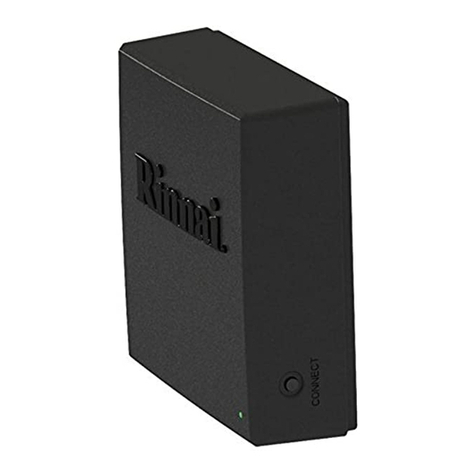
Rinnai
Rinnai Control R quick start guide
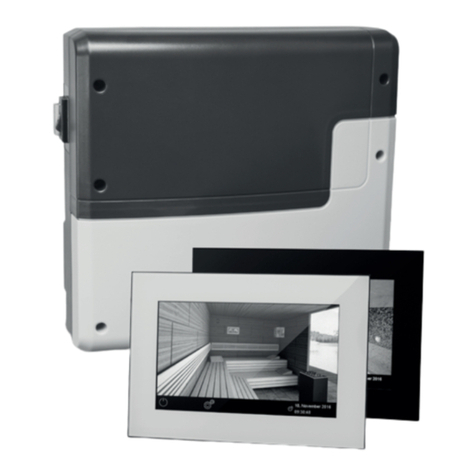
EOS
EOS EmoTouch 3 operating instructions
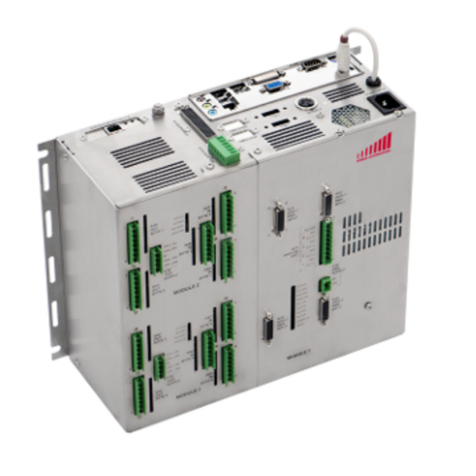
Inovance
Inovance PA 8000 LW installation instructions
